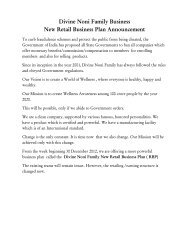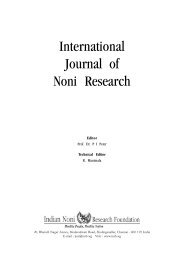International Journal of Noni Research - Noni Family
International Journal of Noni Research - Noni Family
International Journal of Noni Research - Noni Family
Create successful ePaper yourself
Turn your PDF publications into a flip-book with our unique Google optimized e-Paper software.
AIMS AND SCOPE<br />
<strong>International</strong> <strong>Journal</strong> <strong>of</strong> <strong>Noni</strong> <strong>Research</strong><br />
(IJNR) publishes original research and<br />
review articles on all aspects on <strong>Noni</strong><br />
(Morinda citrifolia L.) and other species<br />
<strong>of</strong> Morinda. All submissions will be<br />
reviewed by the editorial board or by external<br />
references. The journal covers: diversity,<br />
cultivation, phytochemistry and clinical<br />
research, etc. related to <strong>Noni</strong>.<br />
Three categories <strong>of</strong> paper will be considered<br />
for publication in IJNR.<br />
1) Reviews<br />
2) Full-length papers<br />
3) Short communications.<br />
SUBMISSION OF MANUSCRIPT (HARD<br />
AND SOFT COPY)<br />
Authors are advised to submit their<br />
manuscripts along with a covering letter to<br />
the Editor, <strong>International</strong> <strong>Journal</strong> <strong>of</strong><br />
<strong>Noni</strong> <strong>Research</strong>, 64, Third Cross Street,<br />
Second Main Road, Gandhi Nagar, Adyar,<br />
Chennai – 600 020.<br />
E-MAIL SUBMISSION<br />
Authors are encouraged to submit their<br />
manuscripts via e-mail as attachment file to<br />
the E-mail ID : mail@worldnoni.com (A<br />
cover letter to be sent with the manuscript).<br />
PREPARATION OF MANUSCRIPT<br />
Two typed copies <strong>of</strong> manuscripts using MS<br />
Word should be submitted. They should be<br />
typed on one side <strong>of</strong> the paper only, doublespaced<br />
with 1.2” margins in all the sides.<br />
All pages should be numbered.<br />
All the accepted articles will be subjected<br />
to editorial revision. A singed statement from<br />
all the authors should be accompanied with<br />
the manuscript saying that<br />
1. the content <strong>of</strong> the article has not been<br />
published in whole or in part elsewhere<br />
2. the article is not currently being<br />
considered for publication elsewhere<br />
3. all necessary ethical safeguards have been<br />
met regarding patient and animal<br />
experimentation, etc.<br />
FULL-LENGTH PAPERS<br />
There is no page restriction on overall length<br />
<strong>of</strong> article. It should be divided into<br />
1) Abstract (100- 200 words) followed by<br />
up to six keywords<br />
2) Introduction<br />
3) Materials and Methods<br />
4) Results<br />
5) Discussion<br />
6) Acknowledgements<br />
7) References<br />
Results and Discussion may be combined.<br />
Title page should be prepared in a separate<br />
sheet, which should provide the title <strong>of</strong><br />
INSTRUCTIONS FOR AUTHORS<br />
paper, name(s) <strong>of</strong> the author(s), name(s)<br />
and address <strong>of</strong> the institution(s) where the<br />
work has been carried out and details <strong>of</strong><br />
the corresponding author with telephone<br />
and fax numbers and e-mail ID.<br />
SHORT COMMUNICATIONS<br />
It should be up to 10 double-spaced<br />
manuscript pages with a short summary <strong>of</strong><br />
50 words. Short communications should<br />
not be divided in to different headings.<br />
However, headings can be used for<br />
Acknowledgements and References. Figures<br />
and Tables should be restricted to a<br />
maximum <strong>of</strong> 2 each. All other style should<br />
be as for Full-length papers.<br />
FIGURES AND TABLES<br />
Figures, figure legends and tables should<br />
be typed on a separate sheet and numbered<br />
consecutively in Arabic numerals.<br />
Photographs should be sharp with glossy<br />
prints. Micrographs, etc. should include a<br />
bar marker to provide an internal measure<br />
<strong>of</strong> scale or magnification should be<br />
mentioned in each microscopic<br />
photograph.<br />
REFERENCES<br />
References in the text should be cited as<br />
follows<br />
Single author: Surendiran (2004) or<br />
(Surendiran, 2004)<br />
Two authors: Surendiran and Mathivanan<br />
(2005) or (Surendiran and Mathivanan,<br />
2005)<br />
Three or more authors: Mathivanan et<br />
al. (2006) or (Mathivanan et al., 2006)<br />
Where two or more than two references are<br />
quoted consecutively in the text,<br />
chronological order should be followed. If<br />
the references are within a year, alphabetical<br />
must be followed. Where references are<br />
made to papers by the same author(s) in<br />
the same year, it should be followed by a, b,<br />
c, etc.<br />
References must be listed alphabetically by<br />
the name <strong>of</strong> the authors at the end <strong>of</strong> the<br />
manuscript. The following style must be<br />
followed to cite the references<br />
<strong>Journal</strong> articles<br />
Abbott, I.A. 1985. The geographic origin<br />
<strong>of</strong> the plants most commonly used for<br />
medicine by Hawaiians. <strong>Journal</strong> <strong>of</strong><br />
Ethnopharmacology 14: 213–22.<br />
Surendiran, G. and Mathivanan, N. 2006.<br />
Antifungal activity <strong>of</strong> Morinda citrifolia and<br />
Morinda pubescens. <strong>International</strong> <strong>Journal</strong><br />
<strong>of</strong> <strong>Noni</strong> <strong>Research</strong> 2: 18-23.<br />
Mathivanan, N., Surendiran, G., Srinivasan,<br />
K., Sagadevan, E. and Malarvizhi, K. 2005.<br />
Review on the current scenario <strong>of</strong> <strong>Noni</strong><br />
research: Taxonomy, distribution, chemistry,<br />
and medicinal and therapeutic values <strong>of</strong><br />
Morinda citrifolia L.. <strong>International</strong> <strong>Journal</strong><br />
<strong>of</strong> <strong>Noni</strong> <strong>Research</strong> 1: 1 – 9.<br />
Books or monographs<br />
Lalithakumari, D. 2000. Fungal Protoplast:<br />
A Biotechnological Tool. Oxford & IBH<br />
Publishing Co., Pvt., Ltd., New Delhi. 184p.<br />
Single author volumes<br />
Mathivanan, N. 2004. Current scenario <strong>of</strong><br />
the biocontrol potential <strong>of</strong> Trichoderma<br />
for the management <strong>of</strong> plant diseases. In:<br />
Emerging Trends in Mycology, Plant<br />
Pathology and Microbial Biotechnology<br />
(Eds. Bagyanarayana, G., Bhadraiah, B. and<br />
Kunwar, I.K.), BS Publications, Hyderabad,<br />
India. pp. 364-382.<br />
Multi-authors volumes<br />
Mathivanan, N., Bharati N. Bhat, Prabavathy,<br />
V.R., Srinivasan, K. and Chelliah, S. (2003).<br />
Trichiderma viride: Lab to land for the<br />
management <strong>of</strong> root diseases in different<br />
crops. In: Innovative Methods and<br />
Techniques for Integrated Pest and<br />
Disease Management (Eds. Mathivanan,<br />
N., Prabavathy, V.R. and Gomathinayagam,<br />
S.), Centre for Advanced Studies in Botany,<br />
University <strong>of</strong> Madras, Chennai, India. pp.<br />
52-58.<br />
Thesis / Dissertation<br />
Surendiran, G. 2004. Antimicrobial<br />
and Wound Healing Activity <strong>of</strong><br />
Morinda tinctoria. M. Sc. Thesis,<br />
University <strong>of</strong> Madras, Chennai, India.<br />
PROOFS<br />
Pro<strong>of</strong> will be sent to the corresponding<br />
author for checking and making essential<br />
corrections. At this stage, no extensive<br />
general revision or alteration will be<br />
allowed. Pro<strong>of</strong> should be corrected and<br />
returned to the editor within 5 days <strong>of</strong><br />
receipt.<br />
OFFPRINTS<br />
Corresponding author will receive the PDF<br />
format <strong>of</strong> the article by e-mail free <strong>of</strong> charge.<br />
A copy <strong>of</strong> the journal will be sent by post to<br />
the corresponding author after publication.<br />
PAGE CHARGES<br />
No page charge for publishing the paper in<br />
the <strong>International</strong> <strong>Journal</strong> <strong>of</strong> <strong>Noni</strong> <strong>Research</strong>.<br />
COPYRIGHT<br />
World <strong>Noni</strong> <strong>Research</strong> Foundation is holding<br />
the copyright <strong>of</strong> all the papers that are<br />
published in the <strong>International</strong> <strong>Journal</strong> <strong>of</strong><br />
<strong>Noni</strong> <strong>Research</strong>. Authors may use the material<br />
elsewhere after publication and authors are<br />
themselves responsible for obtaining<br />
permission to reproduce copyright material<br />
from other sources.








